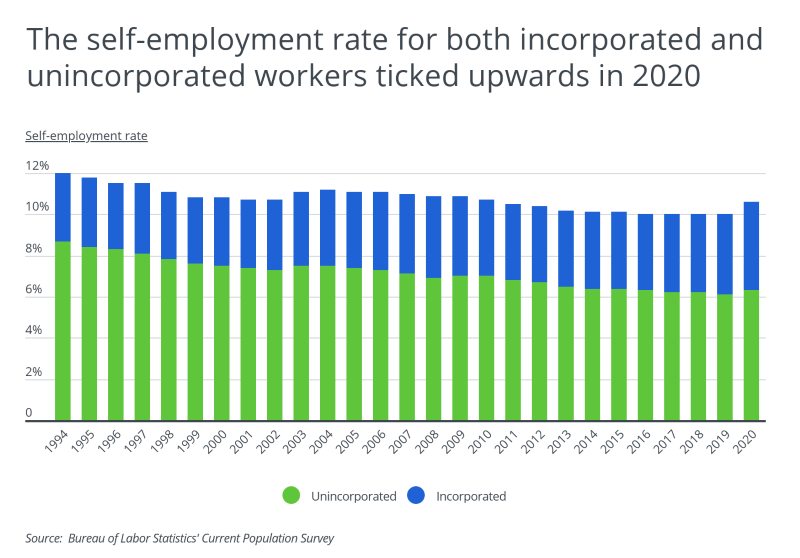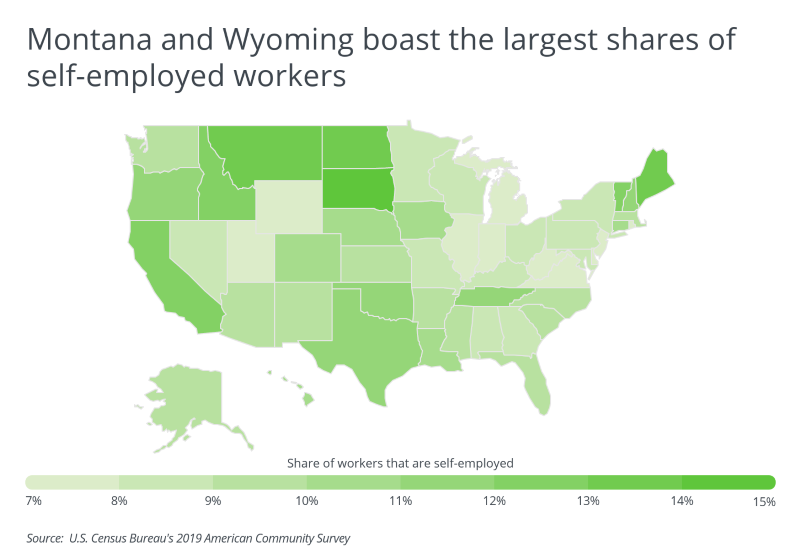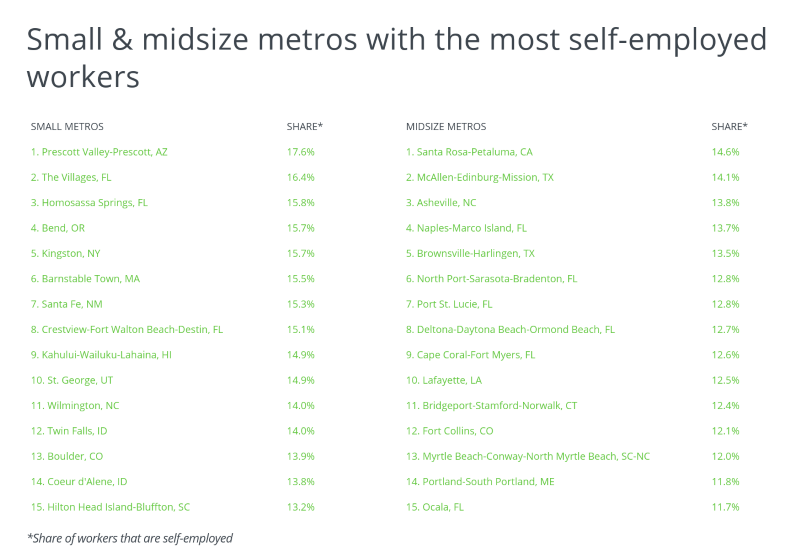Cities With The Most Self-Employed Workers
 Photo Credit: Alamy Stock Photo
Photo Credit: Alamy Stock Photo
March 23, 2021
Nationally, self-employed workers total over 15.3 million, according to the most recent data from the U.S. Census Bureau. While the COVID-19 pandemic has had drastic impacts on the economy as a whole, many small business owners and other self-employed workers have been particularly hard hit.
Two different data sources—the Census Bureau and the Bureau of Labor Statistics (BLS)—pegged the national self-employment rate in the range of 9.6% to 10% for 2019. While recently updated data from the BLS reported a jump from 10% to 10.5% in 2020, the total number of self-employed workers actually decreased from 2019 to 2020. The increase in the self-employment rate can be explained by both an increase in the number of self-employed workers operating their own incorporated businesses and a decrease in the total number of people employed. The U.S. saw a large increase in new business applications in 2020, indicating that some workers likely turned to self-employment after losing their jobs due to the pandemic.

Self-employed workers and the performance of their businesses are crucial to the national economy. Research from the Pew Research Center estimates that while self-employed workers account for just 10% of the workforce, they provide jobs for another 20%, or about 30 million additional workers. The shutdown last spring in the early stages of the COVID-19 pandemic forced many small businesses to close their doors either temporarily or permanently. While government measures including the CARES Act and Paycheck Protection Program helped keep some small businesses up and running, many others missed out on this aid or did not receive enough.
Business incorporation offers owners advantages that may be especially helpful during tough economic times, yet only 37% of self-employed workers incorporate. Incorporation can help business owners protect their personal assets if the business fails or can't pay its debts, and incorporated businesses have easier access to capital. Incorporated business owners are predominantly white and male, meaning other demographic groups are likely to be disproportionately hurt by the economic impacts of the pandemic.
While 10.5% of workers are self-employed at the national level, the self-employment rate varies considerably by location. At the state level, Montana and Wyoming boast the highest shares of self-employed workers in the country, at 14.2% and 13%, respectively. Residents in Florida, Colorado, and California are also among the most entrepreneurial. Conversely, West Virginia has the lowest share of self-employed workers in the U.S., with just 7.1% of its workers employed in their own businesses. Other Rust Belt states like Indiana, Ohio, Pennsylvania, Kentucky, and Wisconsin also have low rates of self-employment.

To find the cities with the most self-employed workers, researchers at HireAHelper used data from the U.S. Census Bureau. The researchers ranked metro areas according to the share of self-employed workers. Researchers also calculated the total number of self-employed workers, the share of self-employed workers in incorporated businesses, the most over-indexed industry for self-employed workers, and the median income for both full-time self-employed workers all full-time workers. The most over-indexed industry for self-employed workers was determined as the industry within a metro that has the greatest difference in self-employment rate when compared to that industry at the national level.
To improve relevance, only metropolitan areas with at least 100,000 people were included in the analysis. Additionally, metro areas were grouped into the following cohorts based on population size:
- Small metros: 100,000–349,999
- Midsize metros: 350,000–999,999
- Large metros: 1,000,000 or more
Here are the U.S. metropolitan areas with the most self-employed workers.

Large Metros With the Most Self-Employed Workers
 Photo Credit: Alamy Stock Photo
Photo Credit: Alamy Stock Photo15. Riverside-San Bernardino-Ontario, CA
- Share of workers that are self-employed: 10.0%
- Total number of self-employed workers: 202,298
- Share of self-employed workers in incorporated businesses: 30.4%
- Most over-indexed industry for self-employed workers: Retail trade
- Median income for self-employed workers (full-time): $45,457
- Median income for all workers (full-time): $46,260
 Photo Credit: Alamy Stock Photo
Photo Credit: Alamy Stock Photo14. Orlando-Kissimmee-Sanford, FL
- Share of workers that are self-employed: 10.1%
- Total number of self-employed workers: 132,951
- Share of self-employed workers in incorporated businesses: 45.9%
- Most over-indexed industry for self-employed workers: Transportation and warehousing, and utilities
- Median income for self-employed workers (full-time): $40,406
- Median income for all workers (full-time): $40,823
 Photo Credit: Alamy Stock Photo
Photo Credit: Alamy Stock Photo13. Nashville-Davidson--Murfreesboro--Franklin, TN
- Share of workers that are self-employed: 10.2%
- Total number of self-employed workers: 104,743
- Share of self-employed workers in incorporated businesses: 28.2%
- Most over-indexed industry for self-employed workers: Information
- Median income for self-employed workers (full-time): $50,507
- Median income for all workers (full-time): $48,749
 Photo Credit: Alamy Stock Photo
Photo Credit: Alamy Stock Photo12. Tucson, AZ
- Share of workers that are self-employed: 10.3%
- Total number of self-employed workers: 47,819
- Share of self-employed workers in incorporated businesses: 27.2%
- Most over-indexed industry for self-employed workers: Manufacturing
- Median income for self-employed workers (full-time): $45,457
- Median income for all workers (full-time): $41,969
 Photo Credit: Alamy Stock Photo
Photo Credit: Alamy Stock Photo11. Portland-Vancouver-Hillsboro, OR-WA
- Share of workers that are self-employed: 10.3%
- Total number of self-employed workers: 132,938
- Share of self-employed workers in incorporated businesses: 38.2%
- Most over-indexed industry for self-employed workers: Educational services, and health care and social assistance
- Median income for self-employed workers (full-time): $60,609
- Median income for all workers (full-time): $56,999
 Photo Credit: Alamy Stock Photo
Photo Credit: Alamy Stock Photo10. Sacramento-Roseville-Folsom, CA
- Share of workers that are self-employed: 10.4%
- Total number of self-employed workers: 117,395
- Share of self-employed workers in incorporated businesses: 29.5%
- Most over-indexed industry for self-employed workers: Transportation and warehousing, and utilities
- Median income for self-employed workers (full-time): $52,022
- Median income for all workers (full-time): $55,665
 Photo Credit: Alamy Stock Photo
Photo Credit: Alamy Stock Photo9. Denver-Aurora-Lakewood, CO
- Share of workers that are self-employed: 10.5%
- Total number of self-employed workers: 173,501
- Share of self-employed workers in incorporated businesses: 45.0%
- Most over-indexed industry for self-employed workers: Information
- Median income for self-employed workers (full-time): $60,609
- Median income for all workers (full-time): $58,633
 Photo Credit: Alamy Stock Photo
Photo Credit: Alamy Stock Photo8. Tampa-St. Petersburg-Clearwater, FL
- Share of workers that are self-employed: 10.6%
- Total number of self-employed workers: 159,600
- Share of self-employed workers in incorporated businesses: 46.7%
- Most over-indexed industry for self-employed workers: Finance and insurance, and real estate and rental and leasing
- Median income for self-employed workers (full-time): $45,457
- Median income for all workers (full-time): $45,007
 Photo Credit: Alamy Stock Photo
Photo Credit: Alamy Stock Photo7. San Francisco-Oakland-Berkeley, CA
- Share of workers that are self-employed: 10.6%
- Total number of self-employed workers: 269,821
- Share of self-employed workers in incorporated businesses: 29.5%
- Most over-indexed industry for self-employed workers: Professional, scientific, and management, and administrative and waste management services
- Median income for self-employed workers (full-time): $70,710
- Median income for all workers (full-time): $76,764
 Photo Credit: Alamy Stock Photo
Photo Credit: Alamy Stock Photo6. Oklahoma City, OK
- Share of workers that are self-employed: 11.0%
- Total number of self-employed workers: 74,237
- Share of self-employed workers in incorporated businesses: 35.6%
- Most over-indexed industry for self-employed workers: Agriculture, forestry, fishing and hunting, and mining
- Median income for self-employed workers (full-time): $50,507
- Median income for all workers (full-time): $45,551
 Photo Credit: Alamy Stock Photo
Photo Credit: Alamy Stock Photo5. Austin-Round Rock-Georgetown, TX
- Share of workers that are self-employed: 11.3%
- Total number of self-employed workers: 138,530
- Share of self-employed workers in incorporated businesses: 35.8%
- Most over-indexed industry for self-employed workers: Information
- Median income for self-employed workers (full-time): $51,012
- Median income for all workers (full-time): $52,453
 Photo Credit: Alamy Stock Photo
Photo Credit: Alamy Stock Photo4. New Orleans-Metairie, LA
- Share of workers that are self-employed: 11.6%
- Total number of self-employed workers: 70,503
- Share of self-employed workers in incorporated businesses: 35.4%
- Most over-indexed industry for self-employed workers: Information
- Median income for self-employed workers (full-time): $50,507
- Median income for all workers (full-time): $45,401
 Photo Credit: Alamy Stock Photo
Photo Credit: Alamy Stock Photo3. San Diego-Chula Vista-Carlsbad, CA
- Share of workers that are self-employed: 12.1%
- Total number of self-employed workers: 196,477
- Share of self-employed workers in incorporated businesses: 29.6%
- Most over-indexed industry for self-employed workers: Information
- Median income for self-employed workers (full-time): $50,507
- Median income for all workers (full-time): $54,584
 Photo Credit: Alamy Stock Photo
Photo Credit: Alamy Stock Photo2. Los Angeles-Long Beach-Anaheim, CA
- Share of workers that are self-employed: 13.2%
- Total number of self-employed workers: 876,710
- Share of self-employed workers in incorporated businesses: 31.4%
- Most over-indexed industry for self-employed workers: Information
- Median income for self-employed workers (full-time): $50,507
- Median income for all workers (full-time): $50,394
 Photo Credit: Alamy Stock Photo
Photo Credit: Alamy Stock Photo1. Miami-Fort Lauderdale-Pompano Beach, FL
- Share of workers that are self-employed: 13.8%
- Total number of self-employed workers: 426,661
- Share of self-employed workers in incorporated businesses: 47.6%
- Most over-indexed industry for self-employed workers: Wholesale trade
- Median income for self-employed workers (full-time): $40,406
- Median income for all workers (full-time): $40,790
Detailed Findings & Methodology
Among large metro areas, Miami boasts the largest share of workers that are self-employed in the country at 13.8%. Miami also has a much larger share of self-employed workers in incorporated businesses at 47.6% compared to 37.2% at the national level. The Miami metro area has fewer large corporations than many other large metros, and it tends to attract a large number of professional and higher-income immigrants who start new businesses.
At the national level, the median income of self-employed full-time workers and all full-time workers is similar, although incorporated self-employed workers tend to earn more. Among large metros with the most self-employed workers, the Information sector—which includes publishing, software, and telecommunications—is a significant economic driver.
Of the small and midsize metros with the most self-employed workers, some had very high levels of self-employment, with rates of 15% or higher. In the Prescott Valley, AZ metro area, 17.6% of workers are self-employed. Self-employed workers in the hardest-hit industries of the pandemic—including the retail, leisure, and hospitality industries—have been disproportionately impacted by the pandemic, as have metros with large concentrations of these industries. However, self-employment can provide an opportunity for workers whose jobs have been lost due to the pandemic, and some metros may see upticks in self-employed workers in the near future.
To find the cities with the most self-employed workers, researchers at HireAHelper used data from the U.S. Census Bureau's 2019 American Community Survey (ACS) and 2019 American Community Survey Public Use Microdata Sample (ACS PUMS). The researchers ranked metro areas according to the share of self-employed workers, including those in both incorporated and unincorporated businesses. In the event of a tie, the metro with the larger number of total self-employed workers was ranked higher.
Researchers also calculated the share of self-employed workers in incorporated businesses, the most over-indexed industry for self-employed workers, and the median income for both full-time self-employed workers and all full-time workers. The most over-indexed industry for self-employed workers was determined as the industry within a metro that has the greatest difference in the share of self-employed workers when compared to that industry at the national level. Median income for self-employed workers was calculated using the ACS PUMS; all other statistics were sourced from the ACS.
To improve relevance, only metropolitan areas with at least 100,000 people were included in the analysis. Additionally, metro areas were grouped into the following cohorts based on population size:
- Small metros: 100,000–349,999
- Midsize metros: 350,000–999,999
- Large metros: 1,000,000 or more